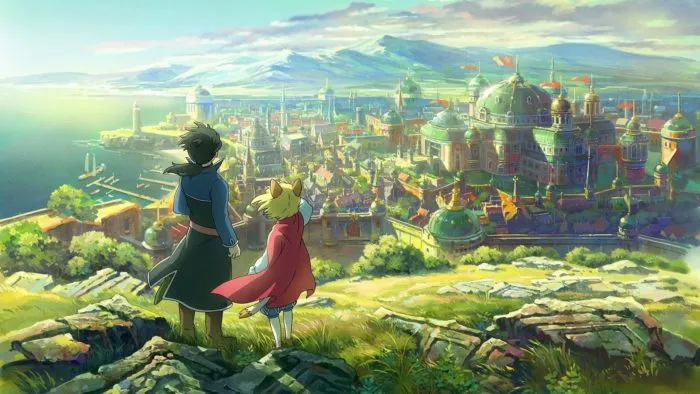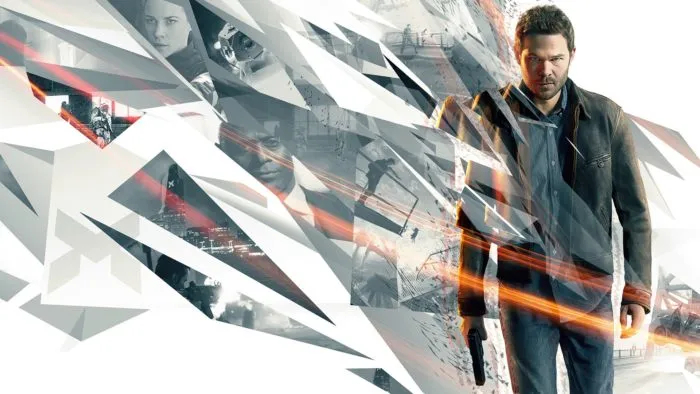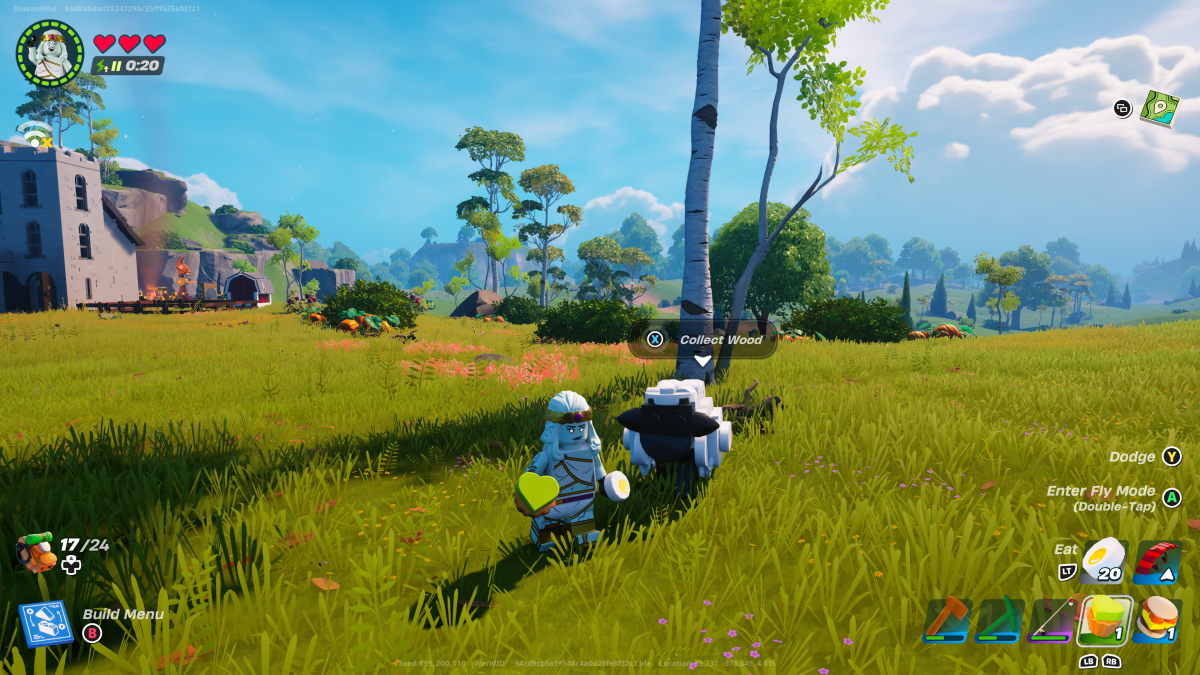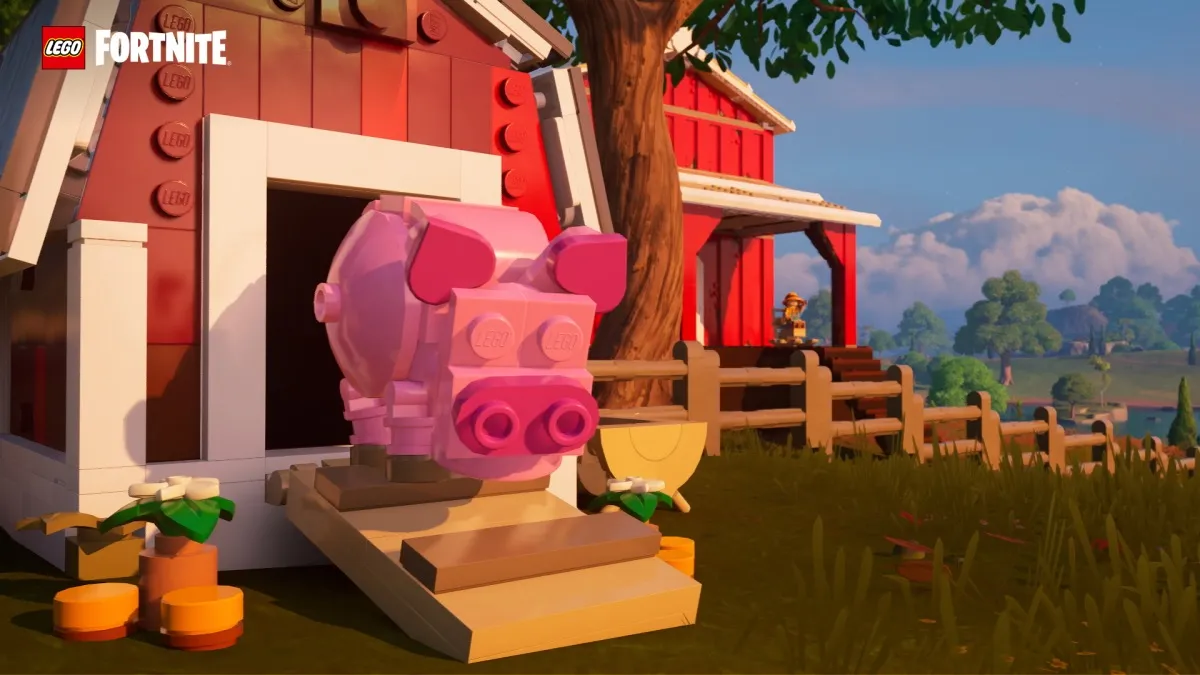Ni No Kuni II: Revenant Kingdom on PlayStation 4
Back in 2013, Ni No Kuni: Wrath of the White Witch deservedly earned critical acclaim for its fresh approach to the JRPG genre. It stood apart from waves of cookie-cutter titles thanks to an innovative battle system, addictive collectathon of adorable familiars, and most importantly, by telling the sort of charming and brilliantly written story reminiscent of some of the genres most iconic games. Unsurprisingly, then, much is expected of its sequel, Ni No Kuni 2: Revenant Kingdom.
In a move that we don’t see all that often in the video gaming industry, rather than rest on its laurels and merely iterate on prior successes, developer Level-5 has instead bravely taken the series in an entirely new direction. Beloved aspects of the first game have been thrown out the window, replaced by new content that refocuses the entire thrust of gameplay. Not to mention, telling an entirely new standalone story. It was a risky move, but thankfully, one that has paid off in a big way. Indeed, Ni No Kuni 2 ends up being much more than just a worthy successor – it’s an exquisite game that matches the lofty heights of its predecessor. In fact, by delivering both a warming narrative and a brilliant gameplay experience, it’s quite simply one of the best games I’ve played this generation.
First, let’s address the elephant in the room: the Studio Ghibli anime cutscenes that were such an iconic feature of the first game are gone, which is an omission that will likely come as a big disappointment for many. Rest assured, though, Ni No Kuni 2 is still utterly gorgeous, and that endearing Ghibli charm does remain intact, even if the cutscenes have a slightly straight-to-DVD feel about them comparatively. But importantly, the aesthetic and design are not only comfortingly familiar for fans, it’s still lush, vibrant, and captivating. The musical score is every bit as brilliant, too, featuring variations of the same triumphant main theme as well as several charming new tunes.
Although there’s plenty of references to the first game, the world of Ni No Kuni 2 is distinct. Evan Pettiwhisker Tildrum, King of Ding Dong Dell, is the game’s protagonist this time around, and little time is wasted throwing players right into the middle of his plight; there’s no slow build-up to proceedings, as there was in the previous game. The opening scene starts frantically, as Roland, a character (presumably) from our world is warped into Ding Dong Dell’s palace at the exact moment a coup is taking place to usurp young Evan from his throne. The two manage to escape, and having been ousted from his kingdom, Evan now seeks to forge a brand new one of his own. But sinister forces in the shape of the mysterious Doloron seek to thwart Evan with a plan that threatens the very fabric of existence for all persons of Ni No Kuni.
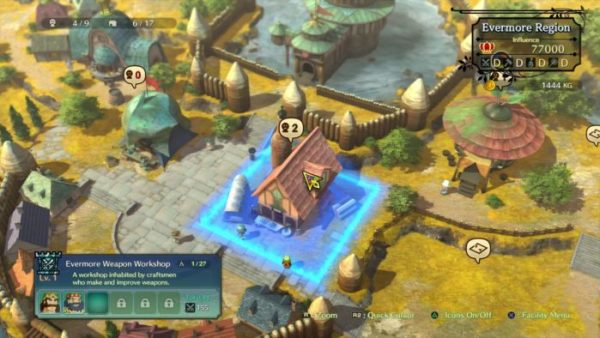
That premise tees up the game’s most substantial new mechanic: kingdom building. In Ni No Kuni 2, the expansion of Evan’s new city of Evermore isn’t merely represented through cinematic cutscenes, it’s physically built by the player themselves. Slightly reminiscent of Suikoden, players are tasked with recruiting citizens and turning Evermore into a bustling metropolis. The township becomes the headquarters not only with respect to the story, but also as a hub for the player in which weapons, armor, spells, and all manner of different resources are farmed. There are dozens of side quests and different errands that reward you with new citizens to join Evan’s cause, who are then put to work to increase production rates and unlock new abilities and items. It’s a system that’s replete with depth, and hugely addictive.
This fledgling nation unsurprisingly catches the attention of rival armies, bandits, and various vagabonds, so it needs defending. But this isn’t done through the game’s standard combat. Rather, Ni No Kuni 2 introduces another layer to the dynamic of its gameplay in the shape of skirmishes. These Clash of Clans-like strategic battles have the player control squads of troops, destroying and capturing objectives on a separate chibi-animated battlefield. Troops are divided into melee and ranged units, with four or more different types centered around Evan and rotated by pressing the bumper buttons. Each unit has special abilities, and there are ways to bolster their strength for more effectiveness before each battle. These encounters don’t require too much strategy, but they are entertaining and make for a welcome change of pace from standard combat.
That isn’t to say the all-new real-time combat system isn’t fun, though. On the contrary, it’s absolutely superb and a huge improvement from the first game. Where before combat was a JRPG hybrid of the Tales and Pokemon series, the second game feels much more Kingdom Hearts. Each battle is a brilliantly dazzling and exciting spectacle, and right from the off, you’re imbued with a sense of empowerment; there’s no fifteen-level wait until you’re able to pull off awesome spells, as is so often the case in JRPGs. Thankfully, companion AI is far better this time around, and you can switch between characters at any moment too. Battles move at a lightning pace as you attack with medium and heavy strikes, defending with blocks and rolls, and then firing off spells and special attacks in between. Each special ability is governed by MP, which is replenished not just via necessary potions but is also accumulated by attacking enemies. It’s a key design choice that places the emphasis of combat firmly on the offensive.
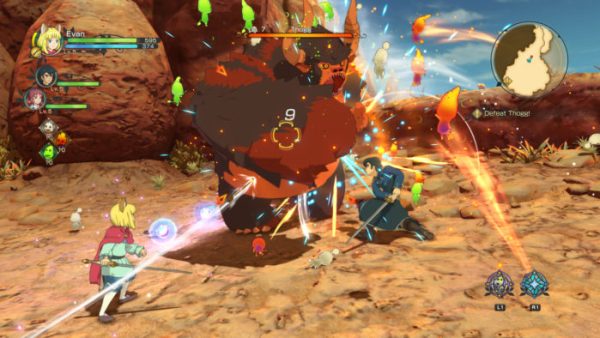
However, while it looks and feels like Kingdom Hearts, it’s refined with far more depth. In addition to coordinating different attacks, abilities, spells, and switching between characters in the heat of battle, players are given the option to make tactical tweaks outside it too. Using the Tactic Tweaker, accumulated points can be poured into adjusting the party’s dynamic. Changes can be made to effectiveness versus certain elements, for example, or whether EXP or items drop more frequently in combat. There’s a tradeoff for each incremental advantage to add strategy, but these can all be reset and adjusted at any time.
Adding another layer to combat are the Higgledies – cutesy Pikmin-like creatures that have replaced the first game’s popular familiars. Unlike before, these cheery and colorful critters don’t fight in place of Evan and co, but instead, provide a helping hand. Each Higgledie has its own unique ability and automatically assists with various buffs. Some turn into enormous cannons that spew flames at enemies, others form a healing safe zone to recover health and magic. There are dozens to collect, “cook”, and then level-up with collected resources. In combat, up to four different types can be used at any on time, and as each battle rages, you’ll be dashing between them to quickly activate their special abilities as they sporadically appear. It’s a system that really does add pace and excitement to combat, and so often satisfactorily turns the tide of battle in your favor right when the odds seem unwinnable.
Not that you’ll be dying much, though, because the first fifteen hours of Ni No Kuni 2 are a complete walk in the park. Initially, this bewildering lack of challenge almost frustrates. With so many exciting nuances to its combat, it doesn’t make sense that you’re able to largely ignore them, plowing through battles and boss fights with punitive ease. The only challenge to be had is outside the game’s main story. So-called Tainted Monsters – harder versions of enemies scattered around the world map. Dreamer’s Mazes, too – special multi-level dungeons that increase in difficulty according to a “danger level” countdown. But the challenge just isn’t there in the main campaign. Until it is.
Suddenly, Ni No Kuni 2 steps up the difficulty, forcing you to up your weapon, armor, and spell research back at Evermore, as well as experiment with different Higgledie combinations. And then it all makes sense. Between kingdom-building, skirmishes, the nuances of combat, creating new Higgledies, and gathering different resources, there are so many layers to Ni No Kuni 2. The difficulty ramp isn’t an oversight, it’s intentional. Rather than overwhelm with its myriad of systems too early, the design allows players time to get comfortable before it starts to push them. And as a result, when things hot up, you aren’t lost as to what to do or how to go about it. It is replete JRPG mechanics made modern and accessible without feeling diluted.
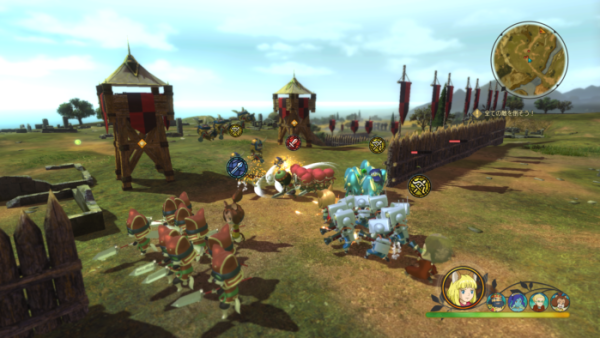
Everything really does come together sublimely during Ni No Kuni 2’s final third. The kingdom building aspects of the game all tie-in directly to the RPG mechanics that govern combat and progression. You’ll find yourself experimenting with building different facilities and assigning new citizens to boost productivity so that you’re able to research new weapons and spells. There’s always some sort of entertaining distraction outside of the main story, but these additional layers all feel suitably related to the narrative. Nothing feels included for the sake of being included. Sure, there’s an almost intimidating amount of content-on-the-side to engage with, and you aren’t able to totally ignore the vast majority of that, but it’s well designed, great fun, and makes sense within the context of the story.
Speaking of which, the excellent storytelling that was the defining feature of the first game is still a key takeaway this time around. Although it may seem so at first, the plot doesn’t merely facilitate the means. It’s a warming tale of uniting different nations and races, overcoming personal greed for the betterment of society as a whole, and with enough mystery and intrigue beyond the obvious happily-ever-after conclusion to compel you to keep driving forward. The writing is, as you’d expect, all very PG, but there’s plenty of cheeky wit that will still crack a smile on the faces of veteran gamers. This brings to life a cast of characters that echo the same endearing warmth that was such a highlight in Wrath of the White Witch.

That being said, I could have gone for a little more depth to some of their personalities. The substance beyond the archetypal character tropes is there in parts but absent in others. As for Evan, he isn’t a hugely complex character, either, and sometimes slightly cringy in his Rated G persona. Yet he is strong-willed and admirably determined to pursue the purity of his cause – a fact that’s highlighted with tongue firmly in cheek one or two times. Of the supporting cast, Roland is a standout and steals the show with his own brilliant plot twist midway through the game. Elsewhere, the game’s main antagonist, Doloron, is intimidating but not quite as memorable as he should be. Perhaps that’s because Ni No Kuni 2’s voice acting is frustratingly lightweight. Where in the first game each character was given a distinct and memorable voice, it’s as if Level-5 ran out of budget this time around. The cinematic cutscenes, too, are few in number, and it does detract slightly from the interest of the story, especially considering that artistic presentation was such a takeaway from Wrath of the White Witch.
That issue is somewhat exacerbated by the fact that you’ll be undertaking almost overwhelming amounts of side quests to recruit new citizens to your kingdom. Alas, Ni No Kuni 2 does force you to grind your way to a higher-level kingdom at various points in the game. These quests feature clever writing, certainly, but when you’re desperately trying to reach a new kingdom level to progress the main story, it’s hard to resist skipping wads of text dialogue to reap the inevitable reward. And they too often boil down to fetching various items or killing monsters, anyway. There are other quests unrelated to recruitment, as well, but since you can farm virtually every resource in the game back at Evermore, I didn’t feel overly compelled to engage with these.
None of the shortcomings, however, are enough to sour what is ultimately an astonishing experience. Once again, Level-5 has risen to the top of a previously floundering but increasingly revitalized genre. Ni No Kuni 2 pushes the envelope and reinvents the wheel while staying true to its JRPG roots. It reminds me of that enchanting escapism and magic of early Final Fantasy games. Yet it recaptures it not through imitation but through the sort of adventurous design that has forged the legacy of some of gaming’s most seminal and iconic games. This second adventure has been worth the long wait in every respect, and I’m already salivating over the prospect of what the future holds for the series. Until then, though, I’m contented to remain at Evermore, immersing myself in the delight of building my very own Revenant Kingdom.
Score: 5/5 – Exemplary
Pros
| Cons
|
For more information on how we review games, check out Twinfinite’s review policy here.

